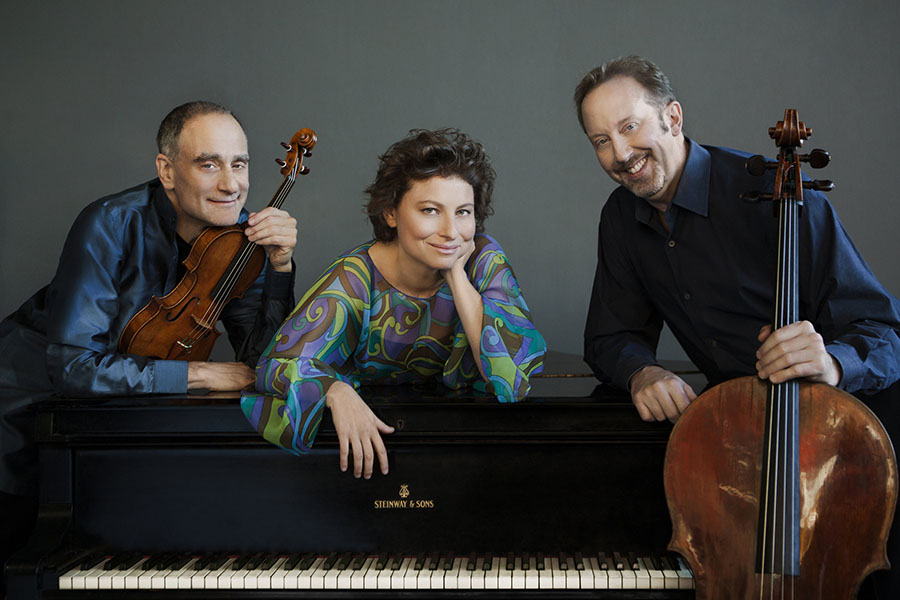With Beethoven – as with other composers – chamber music was, by definition, an intimate and personal means of musical expression. As a result, much of the great maestro’s most beguiling music can be found in this genre – i.e., trios for piano violin and cello. But Beethoven’s most restless and probing mind meant that nearly every chamber genre that he attempted more than once had its formal limits challenged and extended. Thus, his piano trios – like his many other works have a complexity and depth of feeling that have led many critics to naturally describe them as symphonic in scope.
Three outstanding examples of this are the “Ghost”, and the “Archduke” trios, [and the “Kreutzer Sonata”]. The sense of development “above and beyond”, of pushing a genre to its formal and emotional limits, is most dramatically exemplified in those trios played here to perfection by the Weiss Kaplan Stumpf Trio, where the music in question ranges from utterly conventional to works so subjective and experimental that Beethoven’s contemporaries could scarcely regard them as belonging to their given nomenclature – i.e., a trio or a quartet.
Beethoven’s first published works – his Op. 1 – were three trios for piano, violin and cello, and already they show a marked advance on Haydn’s trios in the comparative independence of each of the instrumental parts. Their freedom from Haydn’s oppressive formality looks forward to the more mature trios, the pair that comprises Op. 70 – Piano Trio in D major and Piano Trio in E-flat major – displays displaying all sorts of harmonic twists, thematic innovations, and structural idiosyncrasies.
These trios make much of the piano part[s] and contain outbursts – and emotional intensities – that are typical of Beethoven’s middle period. Most more arresting [probably of all] is the first of the two Opus 70 trios nicknamed “The Ghost” [1808], because of its haunting Largo; its sibling boats a cheerful, bombastic finale that’s the most entertaining music Beethoven ever composed for this combination of instruments.
The so-called Archduke Trio Op. 97 [1811] was Beethoven’s last full-scale work for piano trio and is typically conclusive – like a full-stop to work in this genre. The third movement is its centre of gravity; a highly moving set of variations, with the cello dominating the thematic content, it opens with a hymn-like theme and [progresses to a coda which magnificently sums up the movement’s ideas. The finale may be less powerful than that of Op. 70 Nº 2. But it nevertheless has a sweeping rhythmic power.
The coupling of the “Kakadu Variations” [on disc one] and the Fourteen Variations [on disc three] in this set makes the finest introduction to Beethoven’s Piano Trios. With the excellent performance of the Weiss Kaplan Stumpf Trio this set is the one to go for. Their deeply communicative and musical playing is well suited to these majestic works. Like the legendary Beaux Arts Trio, the Weiss Kaplan Stumpf Trio’s trademark is an uncommonly rich and full tone and the kind of rapt and attentive ensemble that only comes from magical empathy that they wear like a second skin from years of playing together.
Deo gratis…
Music – Disc One – 1 – 3: Piano Trio in D major Op. 70 Nº 1 “Ghost”; 4: “Kakadu Variations” in G major, Op. 121a; 5 – 8: Piano Trio in E-flat major, Op. 1 Nº 1. Disc Two – 1 – 4: Piano Trio in G major Op. 1 Nº 2; 5 – 8:Piano Trio in B-flat major Op. 97 “Archduke”. Disc Three – 1 – 4: Piano Trio in C minor Op. 1 Nº 3; 5: Fourteen Variations in E-flat major Op 44; 6 – 9: Piano Trio in E-flat major Op. 70 Nº 2.
Musicians – Weiss Kaplan Stumpf Trio – Yael Weiss:piano; Mark Kaplan:violin; Peter Stumpf:cello.
Released – 2023
Label – BRIDGE [9505A/C]
Runtime – Disc One 1:17:28 Disc Two 1:07:44 Disc Three 1:14:54


